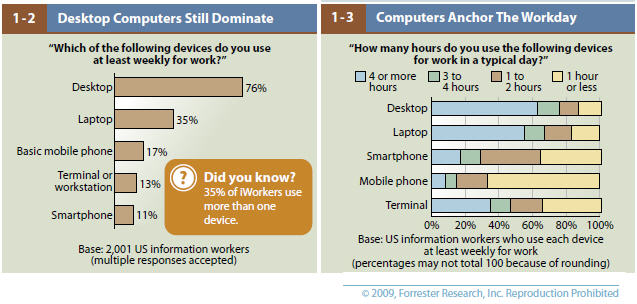Information workers loaded with tech they don't use, need

Forrester Research has published a set of workplace benchmarks that reveal what workers generally need---and don't. The big takeaway: Workers have too much technology and software licenses when they'd really be happy with just a browser, email and a few handy social networking tools.
In a report---the inaugural Workforce Technographics survey---that is designed to reveal the state of the workforce, Forrester details PC usage, mobile tools and what software and Web 2.0 technologies are actually being used.
The theory here is that IT managers should follow the workers lead when it comes to plotting a budget. For instance, does every worker need full-blown Office? Does everyone need a laptop? Are you licensing more software than is actually used?
Among the takeaways from Forrester's survey of 2,001 U.S. information workers:
- Laptops are fancy, but desktops will do. Three out of four information workers use desktops and 63 percent spend more than four hours a day on it. A third of workers, however, use more than one device at least weekly.
- Most applications aren't widely adopted.
- 57 percent of information workers use email hourly. But only 16 percent of information workers use word processors hourly with 14 percent using spreadsheets.
- One in three information workers use a personal mobile phone for work. There's a lot of demand for smartphones.
- One in four workers use Web conferencing (email is the primary collaboration tool).
- Only 14 percent of Generation Y workers use social technologies at work. Ditto for Gen X. Texting is the most popular social tool at work.
In the report Forrester notes:
If there’s a single takeaway, it’s that US information workers are hugely diverse when it comes to technology. iWorkers’ adoption and use of technology varies by industry, profession, and company size, of course, but it also varies hugely based on an employee’s age, income, gender, and technology attitude. Among consumers, we know that technology attitude — tech optimist or pessimist — is a predictor of which people will adopt and use a new technology first. The same is true at work: Technology optimists are far more likely to use devices, collaboration tools, and applications than technology pessimists.
There are a bevy of benchmark graphics in the Forrester report, but here are two of the more interesting ones.
And.
For IT managers, the workforce data is a start to rightsizing technology vendors and licensing. For instance, knowing what workers actually use and view as important will help your software licensing budget. Workforce data can be used to justify tough calls about desktop virtualization and mobile access.
